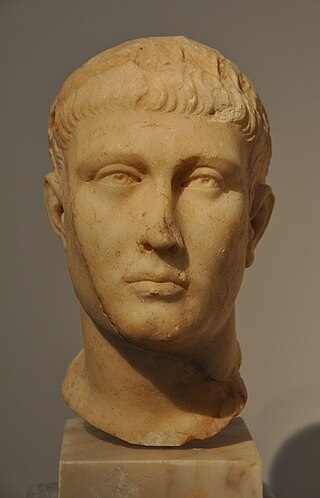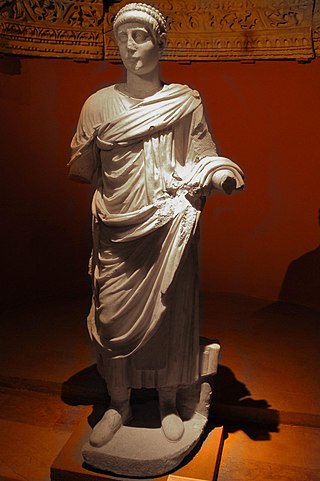
Ambrose of Milan, venerated as Saint Ambrose, was a theologian and statesman who served as Bishop of Milan from 374 to 397. He expressed himself prominently as a public figure, fiercely promoting Roman Christianity against Arianism and paganism. He left a substantial collection of writings, of which the best known include the ethical commentary De officiis ministrorum (377–391), and the exegetical Exameron (386–390). His preachings, his actions and his literary works, in addition to his innovative musical hymnography, made him one of the most influential ecclesiastical figures of the 4th century.

Theodosius I, also called Theodosius the Great, was a Roman emperor from 379 to 395. During his reign, he succeeded in a crucial war against the Goths, as well as in two civil wars, and was instrumental in establishing the creed of Nicaea as the orthodox doctrine for Christianity. Theodosius was the last emperor to rule the entire Roman Empire before its administration was permanently split between the West and East.

Year 394 (CCCXCIV) was a common year starting on Sunday of the Julian calendar. At the time, it was known in Western Europe as the Year of the Consulship of Flavianus without colleague. The denomination 394 for this year has been used since the early medieval period, when the Anno Domini calendar era became the prevalent method in Europe for naming years.
Year 392 (CCCXCII) was a leap year starting on Thursday of the Julian calendar. At the time, it was known as the Year of the Consulship of Augustus and Rufinus. The denomination 392 for this year has been used since the early medieval period, when the Anno Domini calendar era became the prevalent method in Europe for naming years.
The 390s decade ran from January 1, 390 to December 31, 399

Gratian was emperor of the Western Roman Empire from 367 to 383. The eldest son of Valentinian I, Gratian was raised to the rank of Augustus as a child and inherited the West after his father's death in 375. He nominally shared the government with his infant half-brother Valentinian II, who was also acclaimed emperor in Pannonia on Valentinian's death. The East was ruled by his uncle Valens, who was later succeeded by Theodosius I.

Valentinian II was a Roman emperor in the western part of the Roman empire between AD 375 and 392. He was at first junior co-ruler of his half-brother, then was sidelined by a usurper, and finally became sole ruler after 388, albeit with limited de facto powers.
Count Theodosius or Theodosius the Elder, was a senior military officer serving Valentinian I and the Western Roman Empire during Late Antiquity. Under his command the Roman army defeated numerous threats, incursions, and usurpations. Theodosius was patriarch of the imperial Theodosian dynasty and father of the emperor Theodosius the Great.

Victor was a Western Roman emperor from either 383/384 or 387 to August 388. He was the son of the magister militum Magnus Maximus, who later became a usurper of the Western Roman Empire, in opposition to Gratian. Maximus rose up in 383, and was recognized as the legitimate emperor in the west by Theodosius I. Victor was elevated to augustus of the Western Roman Empire in either 383/384 or mid-387, making him co-emperor with his father. Maximus invaded Italy in 387, to depose Valentinian II, the brother and successor of the late Gratian. Because of Maximus' invasion, Theodosius invaded the Western Empire in 388. Theodosius defeated Maximus in two battles in Pannonia, before crushing his army at Aquilea, and capturing Maximus. Maximus was executed on 28 August 388. His death was followed quickly by that of Victor, who was executed in Trier by the Frankish general Arbogast.

The Theodosian dynasty was a Roman imperial family that produced five Roman emperors during Late Antiquity, reigning over the Roman Empire from 379 to 457. The dynasty's patriarch was Theodosius the Elder, whose son Theodosius the Great was made Roman emperor in 379. Theodosius's two sons both became emperors, while his daughter married Constantius III, producing a daughter that became an empress and a son also became emperor. The dynasty of Theodosius married into, and reigned concurrently with, the ruling Valentinianic dynasty, and was succeeded by the Leonid dynasty with the accession of Leo the Great.

The Battle of the Frigidus, also called the Battle of the Frigid River, was fought on 5 and 6 September 394 between the armies of the Roman emperor Theodosius the Great and the rebel augustus Eugenius, in the eastern border of Roman Italy. Theodosius won the battle and defeated the usurpation of Eugenius and Arbogast, restoring unity to the Roman Empire. The battlefield, in the Claustra Alpium Iuliarum near the Julian Alps through which Theodosius's army had passed, was probably in the Vipava Valley – with the Frigidus River being the modern Vipava – or possibly in the valley of the Isonzo.

The Valentinian dynasty was a ruling house of five generations of dynasts, including five Roman emperors during Late Antiquity, lasting nearly a hundred years from the mid fourth to the mid fifth century. They succeeded the Constantinian dynasty and reigned over the Roman Empire from 364 to 392 and from 425 to 455, with an interregnum (392–423), during which the Theodosian dynasty ruled and eventually succeeded them. The Theodosians, who intermarried into the Valentinian house, ruled concurrently in the east after 379.
Justina was a Roman empress. She was initially the wife of the rebel emperor Magnentius and was then married to Valentinian I, with whom she had four children, including the emperor Valentinian II and the empress Galla.
Arbogastes or Arbogast was a Roman army officer of Frankish origin. He won distinction in the service of the emperor Gratian, and was subsequently entrusted by Theodosius I with the guardianship of the underage Valentinian II. The death of Valentinian in mysterious circumstances, and the rise of the controversial Eugenius, led to a civil war in which Arbogast perished.
Galla was a Roman empress as the second wife of Theodosius I. She was the daughter of Valentinian I and his second wife Justina.

The Massacre of Thessalonica in Macedonia, Greece was a massacre of local civilians by Roman troops which is believed to have occurred around 390. According to Sozomen, in June of that year Butheric, a Roman general stationed in Thessalonica as a magister militum was lynched in an urban riot by an angry mob in the circus after having a famous circus charioteer arrested for pederasty, and refusing the people's demand for his release, although, this is found in only one source. In response, Theodosius authorized his Gothic soldiers to punish the people of the city resulting in the killing of a large number of citizens when they were assembled in the city's hippodrome.
Virius Nicomachus Flavianus was a grammarian, a historian and a politician of the Roman Empire.
Nicomachus Flavianus, sometimes referred to as Flavianus the Younger, was a grammarian and a politician of the Roman Empire. He was the son of Virius Nicomachus Flavianus. He held several offices under emperors Valentinian II (371–392), Theodosius I (379–395), Honorius (393–423), and Valentinian III (425–455); together with his father he supported the usurper Eugenius until his defeat and death (392–394). Flavianus also edited a corrected version of Livy's work.
The Edict of Thessalonica, issued on 27 February AD 380 by Theodosius I, made Nicene Christianity the state church of the Roman Empire. It condemned other Christian creeds such as Arianism as heresies of "foolish madmen," and authorized their punishment.
The persecution of pagans under Theodosius I began in 381, after the first couple of years of his reign as co-emperor in the eastern part of the Roman Empire. In the 380s, Theodosius I reiterated the ban of Constantine the Great on animal sacrifices, prohibited haruspicy on animal sacrifice, pioneered the criminalization of magistrates who did not enforce anti-pagan laws, broke up some pagan associations and destroyed pagan temples.










